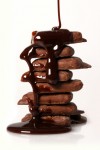Sensory Appeal: Sight Matters
 I’ve written about this topic before, but the fact that food images are powerful marketing tools deserves mention again. In the same Oxford study (see Addictive Foods) that noted that pictures of chocolate triggered areas of the brain associated with addiction when viewed by chocolate cravers, the researchers also examined the response to actual chocolate with and without images.
I’ve written about this topic before, but the fact that food images are powerful marketing tools deserves mention again. In the same Oxford study (see Addictive Foods) that noted that pictures of chocolate triggered areas of the brain associated with addiction when viewed by chocolate cravers, the researchers also examined the response to actual chocolate with and without images.
The volunteers were presented first with appetising pictures of chocolate bars, before being allowed also to taste liquid chocolate fed to them through a tube in the confined space of the scanner.
As expected the cravers consistently rated the experience as more pleasant, but their brains also reacted differently. Three regions thought to be important in pleasure sensation and addictive behaviour – the orbitofrontal cortex, the ventral striatum and the cingulate cortex – were all more active in the chocolate fanciers. “We can tell what people will like from their brain response,” said Prof Rolls. The findings are published this month in the European Journal of Neuroscience.
The study also found that combining the sight and taste of chocolate produced a stronger reaction in both cravers and non-cravers, than either separately. Prof Rolls said this suggests that seeing the food we eat plays a key role in enjoying its taste. [From Brain scans pinpoint how chocoholics are hooked]
Chefs and food critics alike will underscore that visual appeal is important in appreciating food. (I should point out that this study looked only at sight and taste, while it is certain that smell is a critical component of enjoying food and is probably at least as potent as the other senses.) Skilled chefs take care to present their dishes in an attractive and appetizing manner – they understand (without neuromarketing input!) that enhancing the visual appeal will make the food taste better.
Food marketers should follow the old maxim that “a picture is worth a thousand words” – showing people a picture of a food they crave bypasses conscious thought and directly activates the brain.
